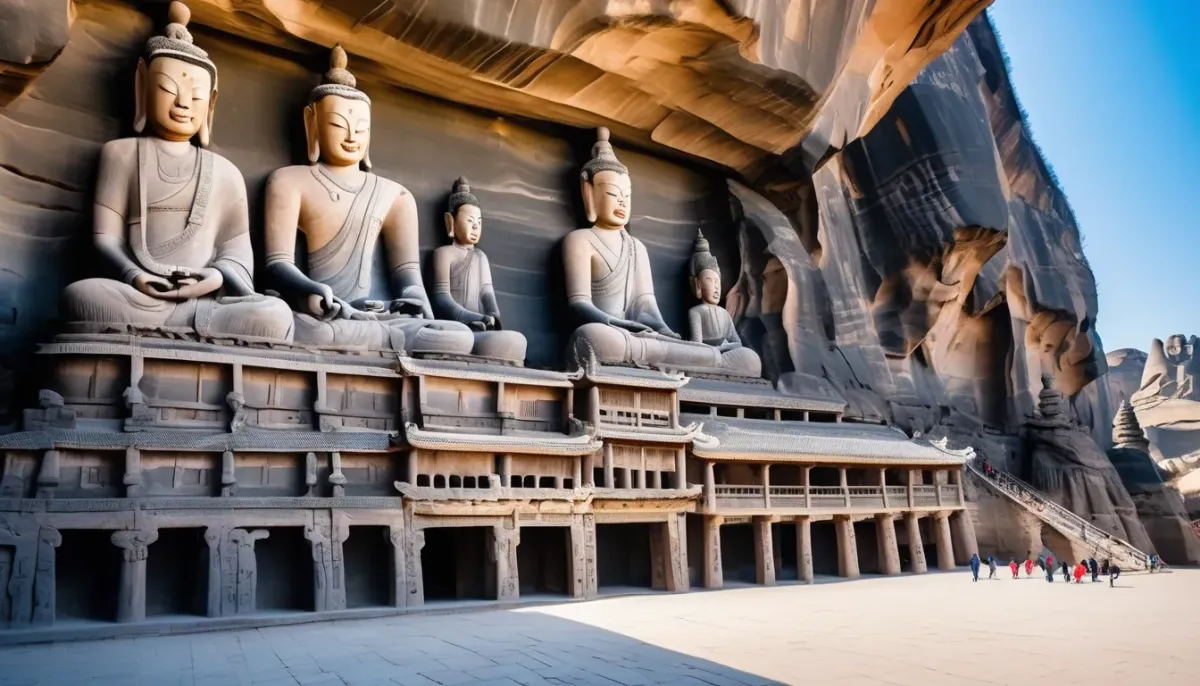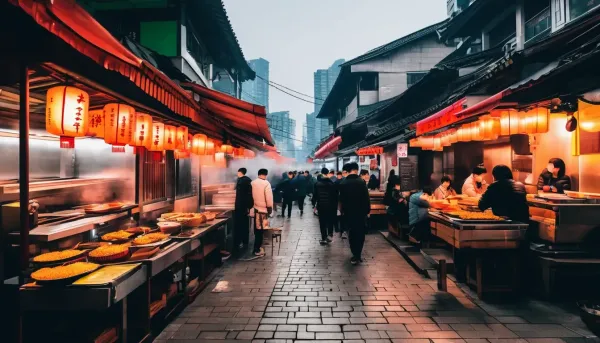Shanxi: Timeless Journey Inspired by Black Myth: WuKong
Shanxi is a truly remarkable destination that offers a unique and unforgettable travel experience. With its rich history, stunning landscapes, and friendly people, Shanxi is sure to leave a lasting impression on all who visit.

Shanxi Province, often overshadowed by its more famous neighbors like Beijing and Xi'an, is a hidden gem waiting to be discovered. This region in northern China has captivated travelers with its rich history, stunning landscapes, and remarkably well-preserved ancient architecture. Recently, the spotlight on Shanxi has grown brighter, thanks to the highly anticipated video game Black Myth: Wukong, which showcases the province's breathtaking beauty in many of its scenes. As a result, Shanxi is emerging as a must-visit destination for those seeking an authentic Chinese experience.
A Treasure Trove of Ancient Architecture
Shanxi is a province steeped in history, with its roots tracing back thousands of years. This rich past is evident in the region's architecture, which has survived the ravages of time to offer visitors a glimpse into ancient China. The province is home to 421 of China's 2,165 national-level cultural relics, making it a veritable treasure trove of ancient architecture. With an astounding 28,640 ancient buildings, more than any other region in the country, Shanxi is a living museum that invites you to step back in time and explore its wonders.
These structures are not just historical artifacts; they are living testaments to the ingenuity and artistry of ancient Chinese civilization. Whether you are walking through the narrow streets of a Ming Dynasty city, standing in awe before a towering wooden pagoda, or exploring a Buddhist cave temple carved into a cliffside, the architecture of Shanxi will leave you spellbound.
Top 10 Must-Visit Attractions in Shanxi
For travelers looking to experience the best of Shanxi, the following ten attractions are must-visits. Each site offers a unique glimpse into the province's rich history, culture, and natural beauty.
1. 云冈石窟 (Yungang Grottoes)
The Yun冈 Grottoes, a UNESCO World Heritage Site, are among the most famous Buddhist cave temples in China. Located near the city of Datong, these magnificent grottoes were carved into a sandstone cliff during the 5th and 6th centuries. The site features thousands of Buddha statues and intricate carvings, ranging from small figurines to towering sculptures over 50 feet tall. The artistry and craftsmanship displayed in the Yun冈 Grottoes are truly breathtaking, making this site an essential stop for anyone visiting Shanxi.
2. 五台山 (Mount Wutai)
Mount Wutai, one of the Four Sacred Mountains in Chinese Buddhism, is a place of deep spiritual significance. Pilgrims from around the world flock to this mountain, which is said to represent the five elements through its five peaks. The area is dotted with ancient temples and monasteries, each with its own unique history and architecture. The serene and tranquil atmosphere of Mount Wutai makes it an ideal destination for those seeking spiritual enrichment or simply a peaceful retreat in nature.
3. 平遥古城 (Pingyao Ancient City)
Pingyao Ancient City is another UNESCO World Heritage Site and one of the best-preserved examples of a Ming Dynasty city. Walking through the narrow, cobbled streets of Pingyao feels like stepping back in time. The city’s ancient walls, traditional courtyard houses, and historic government buildings offer a rare glimpse into life during the Ming and Qing Dynasties. Visitors can also explore the city’s many museums, which house artifacts and exhibits that tell the story of Pingyao’s rich history.
4. 应县木塔 (Yingxian Wooden Pagoda)
The Yingxian Wooden Pagoda, also known as the Sakyamuni Pagoda of Fogong Temple, is the tallest pre-modern wooden structure in the world. Built in the 11th century during the Liao Dynasty, this pagoda stands over 67 meters tall and is a marvel of ancient Chinese engineering. Despite its height and age, the pagoda has withstood numerous earthquakes and remains a testament to the skill and craftsmanship of its builders.
5. 山西晋祠博物馆 (Shanxi Jinci Museum)
The Shanxi Jinci Museum, located in Jinci Park near Taiyuan, is a fascinating destination for history buffs. The museum houses a collection of ancient artifacts, including sculptures, paintings, and calligraphy, that offer insight into Shanxi’s cultural heritage. The park itself is a beautiful oasis, with ancient temples, pavilions, and gardens that provide a serene environment for visitors to enjoy.
6. 壶口瀑布 (HuKou Waterfall)
The HuKou Waterfall is one of the largest and most spectacular waterfalls in China. Located on the Yellow River, the waterfall is known for its powerful and dramatic cascade. The force of the water as it plunges over the cliff creates a thunderous roar and a cloud of mist that can be seen from miles away. Visiting HuKou Waterfall is a breathtaking experience, especially during the rainy season when the river is at its fullest.
7. 雁门关 (Yanmen Pass)
Yanmen Pass is an ancient fortress that played a crucial role in defending China from invaders throughout history. Situated along the Great Wall of China, this pass is one of the most strategic and historically significant sites in the region. Visitors can explore the well-preserved walls, towers, and gates of Yanmen Pass and learn about the military history that shaped the region.
8. 太原植物园 (Taiyuan Botanical Garden)
The Taiyuan Botanical Garden is a haven of natural beauty in the provincial capital. With its diverse collection of plants and trees, the garden offers a peaceful and relaxing environment for visitors. The garden also features several themed sections, including a rose garden, a bamboo grove, and a greenhouse filled with exotic plants. It’s a great place to escape the hustle and bustle of the city and enjoy the tranquility of nature.
9. 悬空寺 (Hanging Temple)
The Hanging Temple, also known as Xuankong Temple, is one of the most unique and awe-inspiring sights in China. This Buddhist monastery is perched precariously on a sheer cliff face, supported by wooden beams and brackets that seem to defy gravity. The temple complex is dedicated to Buddhism, Taoism, and Confucianism, making it a rare example of religious harmony. The Hanging Temple offers not only a spiritual experience but also a breathtaking view of the surrounding mountains.
10. 乔家大院 (Qiao Family Courtyard)
The Qiao Family Courtyard is an impressive compound that was once the home of a wealthy merchant family during the Qing Dynasty. The courtyard is a prime example of traditional Chinese architecture, with its symmetrical layout, intricate carvings, and beautiful decorations. The compound has been preserved as a museum, offering visitors a glimpse into the lives of the wealthy elite during the late imperial period.
Beyond the Top 10: Hidden Gems in Shanxi
While the top 10 attractions provide a great starting point for exploring Shanxi, the province is also home to many lesser-known but equally fascinating sites. These hidden gems offer a deeper insight into the rich cultural and historical heritage of Shanxi.
1. 小西天 (Xiaoxi Tian)
Featured in the video game Black Myth: Wukong, Xiaoxi Tian is an ancient temple complex known for its intricate carvings and beautiful murals. This site is relatively unknown to international tourists, making it a perfect destination for those looking to explore off the beaten path. The temple’s serene atmosphere and stunning artwork make it a must-visit for art and history enthusiasts.
2. 玉皇庙 (Yuhuang Temple)
Yuhuang Temple is a Taoist temple dedicated to the Jade Emperor, the supreme deity in Taoism. This temple, also featured in Black Myth: Wukong, is a place of worship and pilgrimage for Taoists. The temple’s architecture is a fine example of traditional Taoist design, with its ornate decorations and peaceful courtyards. Visitors can learn about Taoist beliefs and practices while enjoying the tranquil surroundings.
3. 铁佛寺 (Tiefo Temple)
Tiefo Temple is home to a large iron Buddha statue, which is believed to have miraculous powers. This ancient temple, though less famous than other religious sites in Shanxi, is a place of deep spiritual significance for local worshippers. The temple’s quiet and secluded location makes it an ideal destination for those seeking a peaceful retreat.
Why Visit Shanxi?
Shanxi offers a unique blend of natural beauty, cultural heritage, and historical significance. Whether you’re interested in exploring ancient temples, hiking through stunning mountains, or simply relaxing in a peaceful setting, Shanxi has something to offer everyone. Here are a few reasons why Shanxi should be on your travel itinerary:
Rich History and Culture: Shanxi is a treasure trove of cultural heritage, with thousands of years of history embedded in its ancient buildings, temples, and monuments. The province’s well-preserved architecture offers a rare opportunity to explore China’s past.
Stunning Natural Landscapes: From towering mountains to cascading waterfalls, Shanxi’s diverse landscapes are a paradise for nature lovers. The province’s natural beauty is complemented by its historical sites, creating a unique blend of natural and cultural experiences.
Authentic Chinese Experiences: Shanxi offers travelers the chance to immerse themselves in traditional Chinese culture and customs. Whether it’s sampling local cuisine, participating in cultural festivals, or learning about ancient Chinese beliefs, Shanxi provides an authentic and enriching travel experience.
Friendly and Welcoming People: The people of Shanxi are known for their hospitality and warmth. Visitors to the province often remark on the friendliness of the locals, who are eager to share their culture and history with travelers.
Noodle Culture of Shanxi
Shanxi province is not only a treasure trove of ancient architecture and stunning landscapes, but it's also renowned across China for its rich noodle culture. As a major noodle-producing region, Shanxi offers a variety of distinctive and flavorful noodle dishes that are sure to delight any visitor. Here’s a guide to some of the most iconic noodle dishes you must try when traveling through Shanxi:
1. 刀削面 (Dao Xiao Mian) - Knife-Cut Noodles
Knife-cut noodles are perhaps the most famous noodle dish from Shanxi. These thick, chewy noodles are skillfully sliced from a block of dough directly into boiling water, creating a unique texture that is both firm and tender. The noodles are often served in a savory broth or stir-fried with various meats and vegetables. The skill involved in cutting the noodles is impressive to watch and is a true art form in Shanxi cuisine.
2. 猫耳朵 (Mao Er Duo) - Cat’s Ear Noodles
Don’t be alarmed by the name; Cat’s Ear Noodles are not what you might think! Named for their small, ear-like shape, these noodles are hand-formed by pinching pieces of dough into tiny, ear-shaped morsels. The texture of these noodles is delightfully chewy, and they are typically served in a hearty broth with vegetables and meat, making for a comforting and satisfying meal.
3. 拉面 (La Mian) - Hand-Pulled Noodles
Shanxi is also famous for its hand-pulled noodles, known as La Mian. These noodles are made by stretching and folding the dough repeatedly until it forms long, thin strands. The noodles are then boiled and served with a variety of toppings, from braised beef to fresh vegetables. The pulling technique requires great skill and is often performed in front of diners, adding an element of entertainment to the dining experience.
4. 刀削面 (Dao Xiao Mian) - Hand-Shaved Noodles
Similar to knife-cut noodles but slightly different in technique, hand-shaved noodles are made by slicing the dough into thin pieces using a special tool. The result is slightly thinner and more delicate noodles. These noodles are often stir-fried with a rich, savory sauce or served in a light broth with various accompaniments. The method of preparation gives the noodles an irregular shape, which enhances their texture.
5. 荞面栲栳栳 (Qiao Mian Kaolaolao) - Buckwheat Rolls
Buckwheat is a staple grain in Shanxi, and Qiao Mian Kaolaolao is a traditional noodle dish made from buckwheat flour. The noodles are shaped into small, hollow rolls, which are then steamed and served with a variety of dipping sauces or soups. The nutty flavor of the buckwheat pairs perfectly with savory sauces, making this dish a must-try for those looking to experience something truly unique to Shanxi.
6. 莜面窝窝 (You Mian Wo Wo) - Oat Noodles
Oat noodles are another specialty of Shanxi, particularly in the northern regions of the province. Made from oat flour, these noodles are shaped into small, tubular rolls and steamed. They are often served with a thick, hearty sauce made from vegetables, meat, and sometimes tofu. The earthy flavor of the oat noodles complements the rich sauce, creating a satisfying and nutritious dish.
7. 剔尖 (Ti Jian) - Pinched Noodles
Ti Jian, or pinched noodles, are small, irregularly shaped noodles made by pinching off small pieces of dough and rolling them into thin strips. These noodles have a slightly chewy texture and are often served in a simple broth with vegetables and meat, allowing the natural flavor of the noodles to shine through. This dish is particularly popular in rural areas of Shanxi and is a true comfort food.
8. 栲栳 (Kao Lao) - Dough Nest Noodles
Another unique noodle dish from Shanxi, Kao Lao, features dough that is formed into small, nest-like shapes. These nests are steamed and served with various toppings or in a flavorful broth. The shape of the noodles allows them to hold onto sauces and broths, making each bite a burst of flavor.
Planning Your Trip
The best time to visit Shanxi is during the spring or autumn months when the weather is mild. Be sure to pack comfortable shoes, as you will be doing a lot of walking.
Transportation
Shanxi is well-connected by air, rail, and road. The provincial capital, Taiyuan, has an international airport and a high-speed rail station. Once in Shanxi, you can get around by bus, taxi, or by renting a car.
Accommodation
There are a variety of accommodation options available in Shanxi, ranging from budget-friendly guesthouses to luxury hotels.
Shanxi province is a destination that encapsulates the essence of China's rich history, vibrant culture, and breathtaking landscapes. From its ancient architecture, such as the UNESCO-listed Yungang Grottoes and the well-preserved Pingyao Ancient City, to its natural wonders like the awe-inspiring Hukou Waterfall, Shanxi offers a journey through time and nature that is unmatched.
Beyond its historical and natural treasures, Shanxi's culinary delights, particularly its renowned noodle dishes, provide an authentic taste of the region’s heritage. Whether you’re exploring sacred Buddhist sites like Mount Wutai, marveling at the engineering feats of the Hanging Temple, or savoring a bowl of knife-cut noodles, Shanxi promises a travel experience that is both deeply enriching and endlessly fascinating.
Visiting Shanxi is not just about sightseeing; it’s about immersing yourself in the stories and traditions that have shaped this remarkable province. The warmth and hospitality of its people further enhance the experience, making Shanxi a must-visit destination for those seeking to uncover the hidden gems of China. Whether you're a history enthusiast, a nature lover, or a food aficionado, Shanxi has something extraordinary to offer.



